Recent months have seen three major oil spills that damaged coastal areas and harmed marine life across different seas. The Black Sea suffered a toxic mazut spill that killed thousands of birds and dolphins. In the Red Sea, a tanker attack nearly caused an environmental disaster. Meanwhile, the North Sea experienced a jet fuel spill following a ship collision. These incidents highlight the ongoing threat of oil pollution to our oceans and the need for better safety measures.
Read more
Black Sea Oil Spill – Russian tanker broken at Kerch Strait. Big disaster at Black Sea.
Red Sea Terrorist attack on Greek tanker.
North Sea aviation fuel leak, Russia sabotage?
The Black Sea Oil Spill: Thick Mazut Damages Wildlife
The Black Sea faced a serious oil spill on December 15, 2024, when two Russian tankers were damaged during a severe storm in the Kerch Strait. The vessels Volgoneft-212 and Volgoneft-239 were carrying mazut, a thick, heavy fuel oil used in shipping. The Volgoneft-212 broke in two and sank, causing one death among its crew. The second ship ran aground near the port of Taman.
The accident released about 3,000 tonnes of mazut into the sea. This thick substance spread quickly to the coastlines of western Krasnodar Krai, most of Crimea, and parts of the Sea of Azov. Mazut is especially harmful because it doesn’t break down easily in water. It sticks to everything it touches and contains chemicals that can cause serious health problems.
“Mazut contamination poses a severe threat to marine ecosystems due to its persistence and toxic properties,” explains marine environmental specialists. The oil coats animals’ feathers and fur, making it impossible for birds to fly and marine mammals to stay warm.
Local volunteers tried to help clean up the beaches and rescue animals. However, many faced health problems from toxic fumes. At least one person may have died from breathing these fumes, and many volunteers needed medical care.
The Russian government’s response to the spill faced criticism for being too slow. By the end of December, the spill had killed about 70 dolphins and between 15,000-20,000 birds. Cleanup efforts continued for months, with workers removing tons of contaminated sand and soil from beaches.
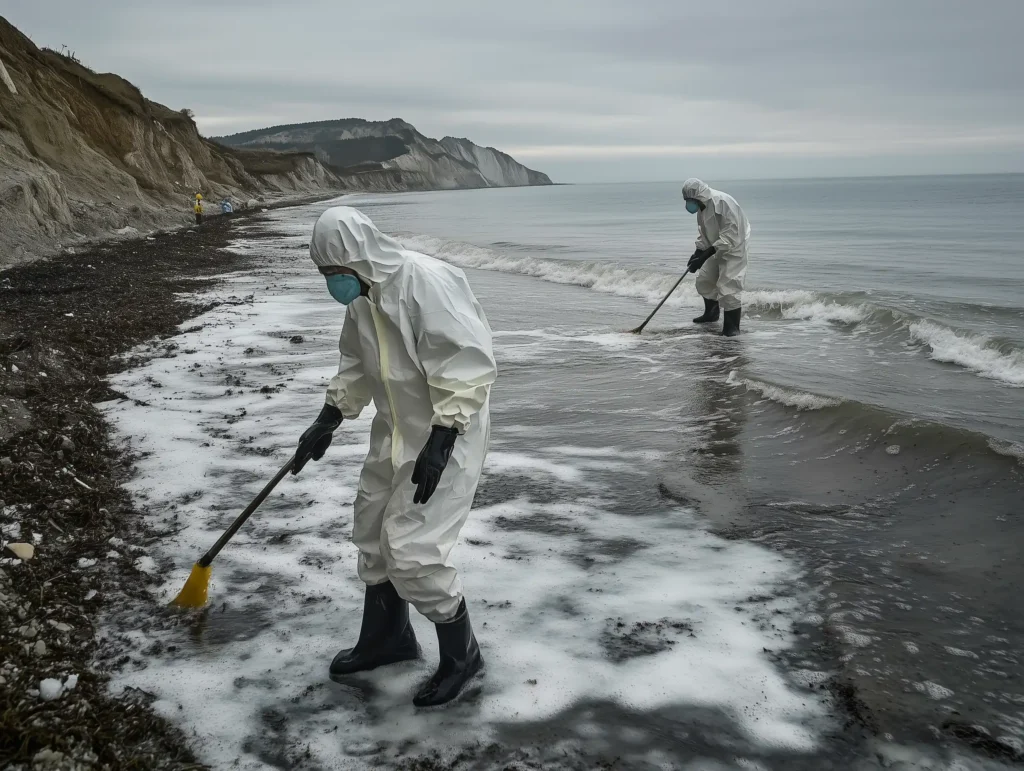
Long-term Environmental Effects
The long-term effects on the Black Sea ecosystem will likely continue for years. The mazut can sink to the seafloor, harming bottom-dwelling organisms and disrupting the food chain. Experts from the International Maritime Organization warn that full recovery of affected areas may take 5-10 years, depending on cleanup success.
The mazut spill also threatens coastal economies that depend on fishing and tourism. Many local fishing operations had to halt their work due to contamination concerns. Tourism businesses near affected beaches expect significant losses in the upcoming seasons.
The Red Sea Tanker Attack: A Near Miss
Unlike the Black Sea disaster, which happened because of a storm, the incident in the Red Sea on January 10, 2025, was caused by an attack. Houthi rebels targeted the oil tanker Sounion, which was carrying about 1 million barrels of crude oil.
The attack damaged the vessel, which caught fire and burned for several weeks. This created serious concerns about a potential environmental disaster in this important shipping lane. If all that oil had spilled, it would have caused massive damage to the Red Sea’s coral reefs and marine life.
“The Red Sea contains some of the most diverse coral reef ecosystems in the world, which would have suffered catastrophic damage from a major oil spill,” notes marine conservation experts. The potential spill threatened not only marine life but also desalination plants that provide drinking water to millions of people in the region.
Economic and Ecological Importance of Red Sea Coral Reefs
The Red Sea’s coral reef ecosystem plays a vital role in supporting local communities through multiple services. These reefs attract millions of tourists annually for diving and snorkeling, generating significant revenue for local businesses. In Egypt alone, reef tourism contributes substantially to economic productivity and improves livelihoods.
The reefs also serve as critical habitats for commercially valuable fish species, supporting both subsistence and commercial fisheries that are essential for food security. Additionally, healthy reefs act as natural barriers against storms and erosion, protecting coastal infrastructure and communities.
The economic value of the Red Sea’s coral reefs is estimated at $160 billion annually through tourism, fisheries, and ecosystem services. A major oil spill would have devastated this fragile ecosystem and the economies that depend on it.
Fortunately, a successful rescue operation saved the tanker before it could leak its cargo. The European Union Naval Forces helped assess the situation and prevent what could have been one of the worst oil spills in recent history.
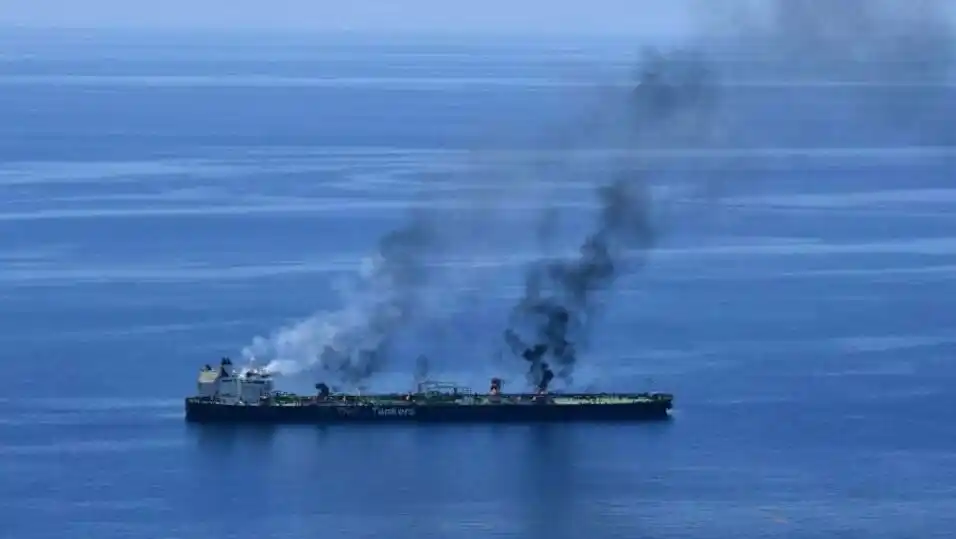
Shipping Route Adjustments and Economic Impact
This incident is part of ongoing security concerns that have forced shipping companies to make significant adjustments to their routes. Many carriers have diverted vessels away from the Red Sea-Suez Canal route, opting for the longer passage around the Cape of Good Hope. This detour adds thousands of miles, increasing transit times by 30-50% and extending shipment times by up to two weeks.
Several major container lines have temporarily suspended operations through the Red Sea until safe passage can be guaranteed. These changes have led to skyrocketing freight costs, with Asia-Europe container rates doubling or tripling in some cases.
This incident shows how political conflicts can threaten the environment. The Red Sea is a vital shipping route that connects Asia, Africa, and Europe through the Suez Canal. Attacks on ships in this area not only endanger crew members but also put fragile marine ecosystems at risk.
The North Sea Collision: Aviation Fuel Spill
The most recent of these three incidents happened in March 2025 in the North Sea. An oil tanker called Stena Immaculate collided with a cargo ship named Solong. The collision caused a fire on the Solong and resulted in one death and several injuries.
The Stena Immaculate was carrying aviation fuel, some of which spilled into the sea. Unlike the thick mazut from the Black Sea spill, aviation fuel is lighter and tends to evaporate and break down more quickly in water. First reports by UK authorities suggested the pollution was “no cause for concern.”
However, there were worries about the cargo ship’s load. The Solong was reportedly carrying sodium cyanide, which would have posed a much more serious threat if released. Thankfully, this hazardous material did not leak into the sea.
“Different types of oil affect marine environments in different ways,” explains European Maritime Safety Agency research. “While lighter fuels like aviation fuel evaporate more quickly, they can still cause short-term toxicity to marine life in the affected area.”
Advanced Monitoring Technologies Track Environmental Effects
Post-spill monitoring of marine life in the North Sea employs a variety of advanced technologies to assess environmental impacts. Underwater drones and remotely operated vehicles (ROVs) capture high-resolution images and videos of marine habitats, allowing scientists to monitor fish populations and seabed conditions.
Satellite remote sensing using optical and synthetic aperture radar (SAR) imaging tracks the movement of the aviation fuel spill, assessing affected areas and predicting potential impacts on ecosystems. Meanwhile, acoustic monitoring systems collect data on marine mammal activity to evaluate how the contamination affects their behavior.
Sensor networks deployed throughout the affected areas measure water quality parameters such as salinity, temperature, pH, and hydrocarbon levels in real-time. This data is processed using artificial intelligence and big data analytics to identify trends and efficiently assess ecosystem health.
These technologies provide critical insights into the spill’s ecological impact and guide cleanup and restoration efforts. Experts believe the lighter nature of aviation fuel will result in less long-term damage compared to the Black Sea mazut spill.
Investigation and Potential Security Concerns
The captain of the Solong, a Russian national, was arrested and charged with manslaughter in a UK court. A full investigation is still underway to determine what caused the collision and assess any environmental damage.
While there is no confirmed evidence of sabotage, some experts have noted this incident occurs amid heightened concerns about maritime security in European waters. In recent years, European authorities have documented numerous incidents involving damage to undersea infrastructure, including pipelines and telecommunications cables in the Baltic Sea.
NATO has increased its presence in northern European waters to deter potential threats to critical maritime infrastructure. The investigation of the North Sea collision will thoroughly examine all possible causes, including human error, equipment failure, and any external factors.
The North Sea has a history of oil spills related to its many offshore drilling platforms and busy shipping lanes. This latest incident may lead to stricter rules about how ships navigate in this area.
Comparing the Three Oil Spills: Different Causes and Effects
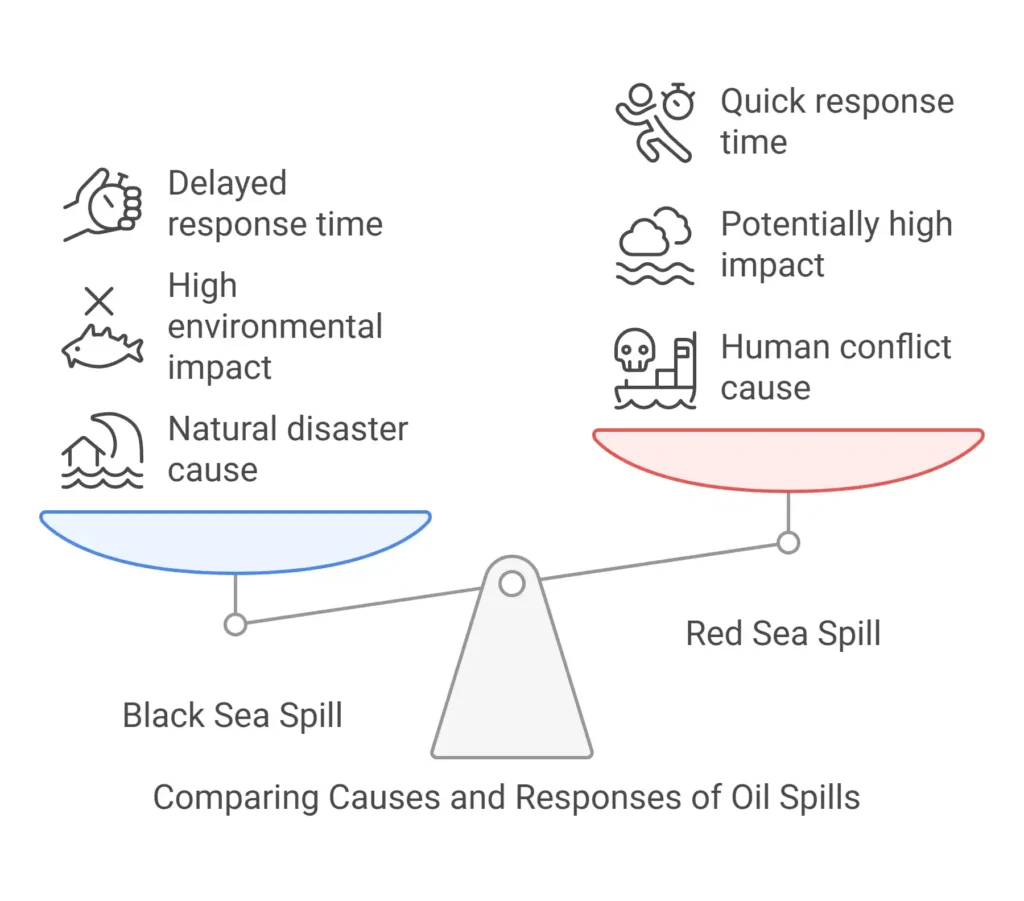
Looking at these three incidents shows the different risks that come with transporting oil and other dangerous materials by sea.
The Black Sea spill was caused by a natural disaster—a severe storm that damaged aging tankers. The Red Sea incident resulted from human conflict—an intentional attack on a tanker. The North Sea collision likely involved human error or equipment failure.
The environmental effects also varied greatly. The mazut from the Black Sea spill caused the most damage because it’s thick, toxic, and stays in the environment for a long time. The potential crude oil spill in the Red Sea would have been devastating if it had occurred. The aviation fuel spill in the North Sea posed a lesser threat because this lighter substance evaporates more quickly.
These differences affect how we clean up oil spills. Mazut requires special equipment and takes longer to remove because it’s so sticky. Lighter fuels need different approaches that focus on containing the spill while the fuel naturally breaks down.
Response times also matter greatly. In the Black Sea case, delays in the official response meant the oil had more time to spread and cause damage. The quick action in the Red Sea case prevented what could have been a much worse situation.
Learning from Recent Oil Spills: Prevention and Safety Measures
These three incidents teach us important lessons about preventing future spills and reducing their impact when they do happen.
For aging tankers like those in the Black Sea, stricter rules about ship maintenance and inspections could help prevent accidents. Better weather forecasting and navigation systems might also help ships avoid dangerous conditions.
To address threats like the Houthi attack in the Red Sea, international cooperation is essential to protect shipping lanes and prevent conflicts from causing environmental disasters.
For busy shipping areas like the North Sea, improved traffic management systems and better training for crew members could reduce the risk of collisions.
All three cases highlight the need for quick, effective responses when spills do occur. Having equipment and trained teams ready to deploy can make the difference between a manageable incident and an environmental catastrophe.
The International Maritime Organization plays a key role in setting standards for ship safety and pollution prevention. Events like the upcoming Interspill Conference 2025 provide opportunities for experts to share knowledge about oil spill prevention and response.
Protecting Our Seas from Oil Pollution
Recent oil spills in the Black Sea, Red Sea, and North Sea remind us of the ongoing risks associated with transporting oil and other hazardous materials by sea. Each incident had different causes and impacts, but all highlight the need for better safety measures and environmental protections.
The Black Sea mazut spill shows the devastating effects of heavy fuel oil on marine ecosystems and the challenges of cleanup. The averted disaster in the Red Sea demonstrates how political conflicts can threaten environmental safety. The North Sea collision raises questions about navigation safety in busy shipping lanes.
By strengthening maritime safety regulations, improving spill response capabilities, and fostering international cooperation, we can better protect our oceans and coastlines from these harmful events.
Frequently Asked Questions About Oil Spills
How many gallons is a barrel of oil?
One barrel of oil equals 42 gallons. This standard measurement is used throughout the oil industry to quantify both production volumes and spills.
What color is an oil slick?
Oil slicks vary in color depending on thickness. They typically appear as silver/gray sheens when very thin, rainbow-colored when slightly thicker, and dark brown or black when the oil forms a substantial layer. These color differences help experts assess the severity and extent of spills from aerial observations.
What are the 3 largest oil spills in the world?
The three largest oil spills in world history are:
- The Gulf War Oil Spill (1991) – 240-336 million gallons deliberately released into the Persian Gulf during the conflict
- The Lakeview Gusher (1910-1911) – approximately 378 million gallons from a well blowout in California that continued for 18 months
- The Deepwater Horizon disaster (2010) – 210 million gallons released into the Gulf of Mexico
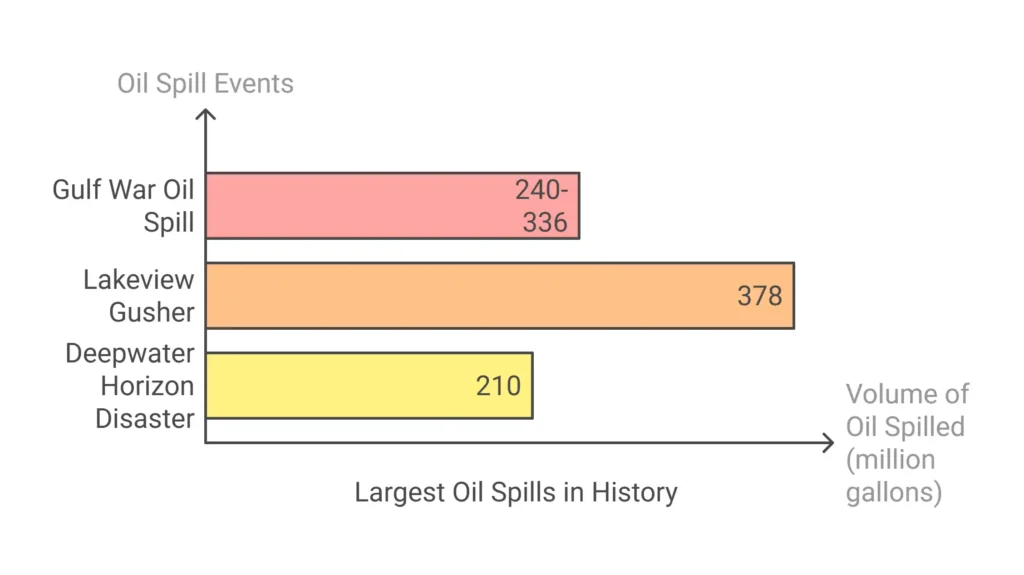
How many animals died in the Deepwater Horizon oil spill?
The Deepwater Horizon disaster caused extensive wildlife casualties. Estimates suggest thousands of marine mammals, sea turtles, and up to one million seabirds died. The spill affected approximately 70,000 square miles of ocean habitat, damaging ecosystems throughout the Gulf of Mexico.
Who is trying to stop oil spills?
Multiple organizations work to prevent and respond to oil spills, including:
- The International Maritime Organization (IMO)
- Government agencies like the EPA and Coast Guard
- Industry groups and oil companies
- Environmental organizations
- Scientific research institutions
- Maritime safety authorities
These groups develop technologies, regulations, and response protocols to reduce the risk and impact of oil spills worldwide.

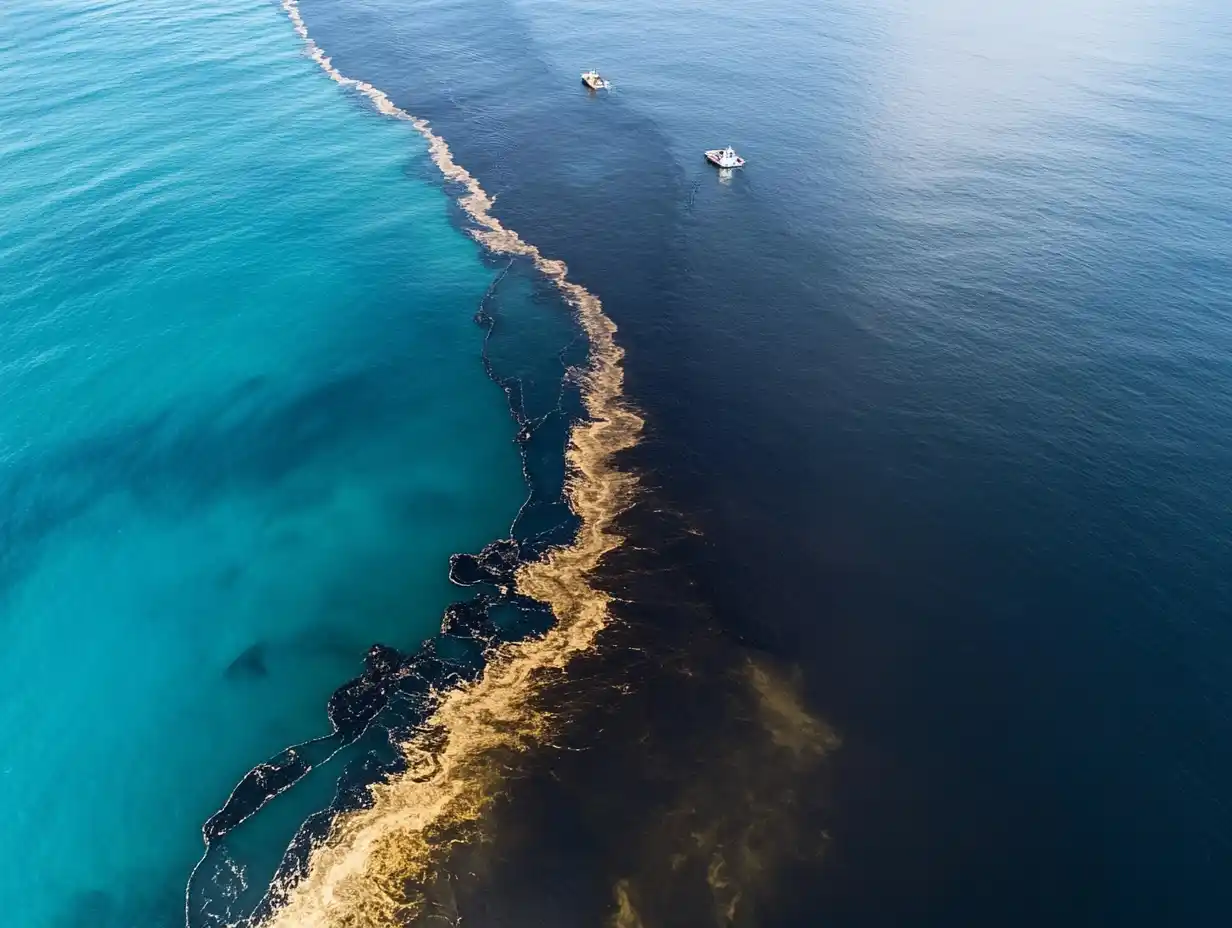
Leave a Reply